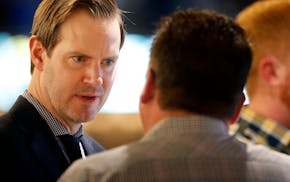Jim Fregosi played his first pro game in 1959. He was an All-Star with the California Angels and a manager with four big-league teams and has been a special assistant to the general manager with the Braves for the past 11 years.
In this case, the special assistant to the GM scouts the four teams in the Tampa Bay area in spring training, and sees all 30 teams during the season.
Add it up and this baseball man sees 200 big-league games a year. On his rounds, Fregosi will hear conversations on OPS, VORP, WAR, UZR and the other new-age acronyms that are supposed to quantify the value of a ballplayer.
"What most people don't understand is that statistical analysis has been used in baseball since I started in the game," Fregosi said. "I knew what my on-base percentage was in the low minors in 1959.
"What we didn't do was take percentages for two different things, like on-base and slugging, and say this one number tells you more about a hitter's value to a team than anything else.
"A number like that can't take into account how the player fits on your club. If I'm looking for a leadoff hitter, I don't care about a combination of numbers -- don't care about his slugging percentage. I want to know how often he gets on base and if he can run.
"If I'm looking for a utility infielder, I don't care about OPS. I want to know if he can catch the ball and play three positions."
John Schuerholz and the Braves' current GM, Frank Wren, created an organization that Fregosi believes has more pro scouts covering North America than any other organization.
"By the All-Star Game, we will have a report from one of our scouts on every player with a full-season club in the minor leagues," Fregosi said. "This is an organization where we see players play before a decision is made on them.
"There are too many things that can't be seen through statistics -- how does a player react to a situation, how does he fit in the game, fit with a team. You can't just look at OPS. You need a total picture before you're going to sign a player, or trade for a player."
Fregosi said the stats that get on his nerves the most involve those that try to put a number on player's fielding range. One of those is UZR (ultimate zone rating).
"I can watch any player for three days and tell you if he has range -- and I'll tell you more accurately than a chart in a computer," he said.
My favorite absurdity among the new stats is WAR (wins above replacement). This is supposed to tell you how many games a team might have won with J.J. Hardy playing shortstop than it would have with a readily available player (for instance, Alexi Casilla).
I mentioned to Fregosi a recent argument with a 25-year-old stat-head in which he tried to convince me of WAR's value by pointing out Henry Aaron and Willie Mays ranked very high in the category.
Fregosi laughed slightly and said: "I guess that confirms it -- the Hammer and Willie were good players. And [Roberto] Clemente probably did pretty well, too."
Back in 2009, Fregosi was in the Metrodome on a scouting mission. It was midsummer of Delmon Young's second season with the Twins. The outfielder was such a disappointment that he was in the lineup only part time.
I was giving Fregosi a negative review of Delmon -- particularly the manner in which he was getting tied up with his swing as he tried to inside-out pitches to right field.
"I'd take him," Fregosi said. "He hits more 400-foot home runs foul to right field than any righthanded hitter in history. He's strong. He has bat speed. Delmon will figure it out."
I reminded Fregosi of that conversation last week.
"I give the Twins a lot of credit on Delmon," Fregosi said. "After that first season he had for them, there are clubs that would've moved him. The Twins hung with him. Worked out OK for them, I'd say."
And it took real baseball men -- not dweebs married to OPS and other phony numbers -- to read the bat speed and understand Young was worth the wait.
Patrick Reusse can be heard noon-4 weekdays on 1500ESPN. • preusse@startribune.com

Reusse: How bad are the White Sox? They made Twins look good.

Reusse's Tortured Columnist Department update: Yes, Vikings won the offseason

Reusse: Wolves need stopper for Booker? NAW, it's not a problem.

Reusse: Success on court helped Timberwolves do strong business


